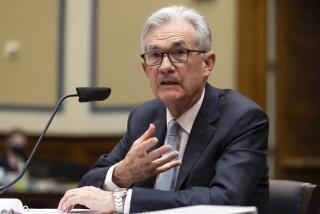Administration Sees 4% Growth Through 1988
WASHINGTON — The Reagan Administration projected Monday that the sputtering economy would pick up steam and grow at the robust rate of 4% a year through 1988 after adjustment for inflation.
Beryl W. Sprinkel, chairman of President Reagan’s Council of Economic Advisers, described the estimate as “realistically optimistic,” and some economists agreed.
But others insisted that it was far too rosy. Blue Chip Economic Indicators of Sedona, Ariz., which regularly polls about 50 economists, found that their expectations for economic growth next year averaged only 3.1%.
And some economists said that the risk of recession was growing as the recovery from the 1981-1982 recession moved into its fourth year. “The economy is just wearing out,” said A. Gary Shilling, who heads a New York-based economic forecasting firm.
Declining Inflation
The Administration, in addition to projecting healthy economic growth in coming years, forecast falling inflation after 1987 and steady declines in both unemployment and interest rates.
Its economic outlook assumes that the federal budget deficit will gradually shrink to zero by 1991, as mandated by the recently enacted Gramm-Rudman law, and that Congress will enact tax overhaul legislation close to the Administration’s proposal. Although it projects that the 1986 trade deficit will exceed this year’s record, it forecasts improvement in the nation’s trade position toward the end of next year.
The forecast, which was prepared by the Council of Economic Advisers, the Treasury Department and the Office of Management and Budget, will provide the economic underpinnings for President Reagan’s fiscal 1987 budget proposal to Congress in February.
Sprinkel said that the deficit in the Administration’s budget will meet the Gramm-Rudman ceiling of $144 billion. He refused to disclose the magnitude of the spending cuts necessary to reach that total, but OMB Director James C. Miller III has said cuts of about $50 billion will be required.
The Administration’s new economic forecast echoes that of a year ago, when it projected 4% growth for 1985. But, with nearly complete data for 1985 now available, actual growth is expected to be only 2.8%.
Bases of Forecast
Sprinkel said that the Administration based its current outlook for vigorous economic growth on a variety of factors--a healthy increase this year in the index of leading economic indicators, relatively low inventory levels and the recent rapid expansion of the nation’s money supply.
But, only hours before the Administration disclosed its forecast, the Commerce Department announced the lowest increase since June in the index of leading indicators, the government’s primary economic barometer. However, many economists discounted the significance of the modest 0.1% rise in November, saying that the index fluctuates wildly and is likely to show a sharp rise in December.
“Those numbers jump around,” Richard Rahn, chief economist for the U.S. Chamber of Commerce, said. “The trend has been, I think, healthy.” The index has risen by 4% in the last 12 months.
Economist Concurs
Among the economists who agreed with the Administration’s new economic projection, at least in the near term, was John M. Albertine, president of the American Business Conference, a coalition of mid-size, fast-growth firms. “It’s pretty consistent with the forecast we have,” he said.
If Congress can bring the budget deficit under control--and Albertine predicted that the Gramm-Rudman law would “really force a resolution of this problem”--the outlook is “clearly for a fundamentally sound economy for the next three or four years,” he said.
David Ernst, vice president of Evans Economics in Washington, agreed that economic growth of 4% in 1986 was likely. But he questioned whether growth would continue at that rate beyond next year.
Tax Hike Expected
Despite President Reagan’s opposition, Ernst said, a tax increase is likely in late 1986 or 1987 as a deficit-reduction measure, and he said that that would “take some steam out of the economy.” Similarly, he predicted that interest rates and inflation would not show the declines predicted by the Administration.
Nor does Ernst expect the increase in consumer spending that Sprinkel saw as the driving force behind economic expansion.
“There’s a limit to how many cars and televisions and stereos and VCRs and so forth that anyone can buy,” he said.
More to Read
Get the L.A. Times Politics newsletter
Deeply reported insights into legislation, politics and policy from Sacramento, Washington and beyond. In your inbox three times per week.
You may occasionally receive promotional content from the Los Angeles Times.










